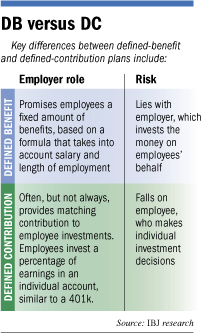Subscriber Benefit
As a subscriber you can listen to articles at work, in the car, or while you work out. Subscribe NowLawmakers are mulling converting the state’s pension system into a 401(k)-like model, bringing Indiana into the heated national debate over public pensions.
 Former pension official Craig Hartzer, left, is concerned a 401(k)-like system would put too much risk on employees. Rep. Brent Waltz called making the switch a “no-brainer.”
Former pension official Craig Hartzer, left, is concerned a 401(k)-like system would put too much risk on employees. Rep. Brent Waltz called making the switch a “no-brainer.”This legislative session, Sen. Brent Waltz, R-Greenwood, plans to introduce a bill that would require all new hires of the state, as well as schools or local governments, to have a so-called defined contribution plan. It’s similar to a bill he introduced last session that did not get a vote.
His introduction of the bill will follow the state’s Pension Management Oversight Commission’s first public vetting of the pros and cons of defined contribution plans earlier this fall.
The moves come as states such as Rhode Island and Illinois grapple with burgeoning pension liabilities their cash-strapped budgets can’t afford to cover. The $22.2 billion Indiana Public Retirement System is stable by comparison, but losses to the fund in the recent financial downturn have prompted Indiana leaders to re-examine whether taxpayers should bear the liability of ensuring public employees a certain amount of benefits.
That question becomes increasingly pressing as retirees live longer, requiring states to cover pension liabilities for additional years.
 “The government is in volatile investment times with rising benefit costs, rising health care costs and an increasing number of retirees every year,” said Sen. Greg Walker, R-Columbus, who spearheaded the recent discussion as head of the oversight commission. “We need to be talking about how we best protect employees of the state.”
“The government is in volatile investment times with rising benefit costs, rising health care costs and an increasing number of retirees every year,” said Sen. Greg Walker, R-Columbus, who spearheaded the recent discussion as head of the oversight commission. “We need to be talking about how we best protect employees of the state.”
In defined benefit plans, or pensions, employers guarantee annual retirement benefits for employees. Money for those benefits comes from contributions made by employers—such as cities, counties and the state—and investment returns.
Defined contribution plans, in contrast, require workers to contribute to a retirement account, with employers typically offering a matching contribution.
The private sector largely has traded pensions for 401(k)s, in part because the plans provide companies with greater certainty about what benefit costs will be, regardless of the investment climate.
But discussion about whether governments also should embrace them remains controversial.
Opponents, including public sector unions, argue the expense of transitioning to a defined contribution system—while maintaining benefits to existing retirees—can be prohibitive. That’s because public pension systems have to fund ongoing benefits for retirees and existing employees who have pensions, but have fewer members over whom to spread the cost, since employers instead are contributing to their employees’ individual accounts.
Critics also question whether it’s good public policy to put investment risk and decisions on employees.
Key to the debate in Indiana is how well-funded the pension system is—a factor that drives whether change is necessary to protect employees and taxpayers. Indiana’s unfunded liabilities as a percentage of assets are small in comparison with struggling states’, but some question the accuracy of the state’s assumptions.
A ‘no-brainer’?
Nationwide, three states mandate defined contribution plans for state employees, and another eight states offer it as an option.
Indiana is among just four states that have a plan with both a defined benefit and defined contribution component, a system that has been in place since 1955. Employees are required to contribute 3 percent of pay to an account similar to a 401(k)—a cost employers sometimes cover. Employees also receive a fixed amount of benefits upon retirement if they were vested in the state’s pension plan after 10 years.
During the last session, the General Assembly passed a law allowing new state employees to elect to have only a defined contribution plan.
Moving further toward a defined contribution retirement system could take on many forms. Under Waltz’s last bill, existing retirees and employees would keep their defined benefit plans, but new hires would have only defined contribution plans.
Both employees and employers would have contributed a minimum of 3 percent of an employee’s salary to the plans.
Waltz said the move is a “no-brainer,” primarily because it eventually removes the hundreds of millions in liabilities taxpayers shoulder to fund public pensions.
But others say the benefits are not so clear.
They point out that states can incur additional costs initially to convert from pensions to defined contribution plans. They also say management fees tend to be higher for defined contribution plans.
According to a 2010 report by the National Association of State Retirement Administrators, the average cost for administering a defined benefit plan is about 0.5 percent of assets, compared with 1.25 percent to 2 percent for a defined contribution plan.
Steve Russo, executive director of the Indiana Public Retirement System, said it’s easier to negotiate more competitive management fees for a massive investment pool such as a pension.
And some critics say that switching to a defined contribution plan could put public employees at risk of not having enough retirement savings.
“If you mandate a defined contribution plan for all new employees, what you’ve done is shifted all the investment risk to the employees, and most employees are not very literate about investments,” said Craig Hartzer, former executive director of the state’s Public Employees Retirement Fund, which includes state, local and university employees.
“If you go to a defined contribution plan, you have to combine it with an intense amount of financial literacy training.”
Funding level at issue
Proponents of defined contribution plans, however, see those challenges as surmountable.
Phil Troyer, a lawyer with the Fort Wayne-based employee benefits firm Law Offices of Robert Toth Jr., who testified in favor of defined contributions at the pension oversight hearing, said the state could shop the remaining pension liabilities to private insurers. That would be costly to cover in the short run, but it would remove the liability from taxpayers.
And Waltz argues that, although management fees would be higher, the state could put the onus of covering those on employees.
“The taxpayer would come out many millions of dollars ahead each year,” said Waltz, an entrepreneur and investment banker. “I don’t view this as being anti-union or anti-state-employee. It’s transitioning the current structure, which is decades out of date, and bringing it in line with the 21st century.”
Some disagree that the system needs reform—given the relative stability of Indiana’s pension system compared with those in other states.
The Indiana Public Retirement System, which includes pensions for state and local employees, judges, teachers, prosecutors and public safety, was about 87.5 percent funded as of June 2010, the most recent figures available. The U.S. Government Accountability Office considers 80 percent acceptable. By comparison, Illinois’ pension system is about 54 percent funded.
However, Indiana is still working to catch up on funding an old teacher pension fund whose benefits were covered through an annual state appropriation until 1996 in what is called a pay-as-you-go system.
State officials project that, with annual state appropriation increases of 3 percent and $30 million in yearly lottery revenue, it can be fully funded by 2037. The pension was 33.1 percent funded as of June 2010.
Still, Indiana’s relatively solid position has caused some to question why change is necessary.
“When you have a system that’s well-constructed and well-conceived, then why fool with it?” said Tom Hanify, president of the Professional Firefighters Union of Indiana, whose public safety pension fund is among the state’s strongest at 93 percent funding. “You want to fix something that’s not broken.”
Waltz, though, questions the accuracy of the state’s valuation of its pension assets because some are highly illiquid. About 28 percent of PERF’s assets, for example, are in investments such as real estate, hedge funds and private equity.
“The valuation is not going to be accurate,” Waltz said, “because you’re dealing with things that are highly subjective.”
A majority of the fund is valued daily, and values are audited by a third party.•
Please enable JavaScript to view this content.
